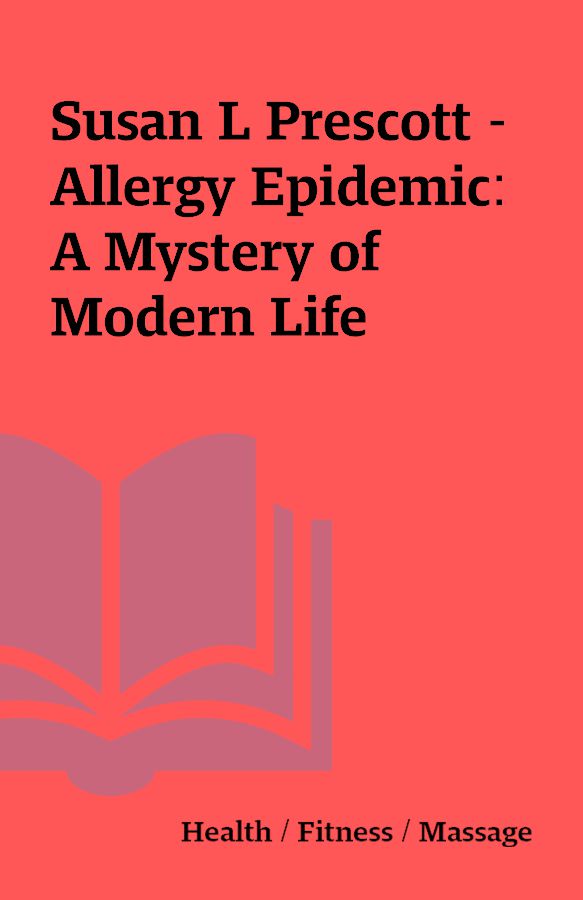Susan L Prescott – Allergy Epidemic: A Mystery of Modern Life
Susan L Prescott – Allergy Epidemic – A Mystery of Modern Life.pdf
[Ebook – PDF]
Description
Allergy Epidemic: A Mystery of Modern Lifeby Susan L PrescottEnglish | ISBN: 1742582915 | 2011 | 304 pages | PDF | 4 MBAs an internationally renowned specialist in childhood allergy and immunology, Prof. Susan Prescott takes us on a journey into the science behind the allergy epidemic. As both an allergy specialist working in a busy children’s hospital and as a cutting edge research scientist, Prescott is perfectly placed to explore how and why we are experiencing an epidemic rise in allergic diseases, as well as the practical side of dealing with these potentially serious conditions. With clear, no-nonsense explanations and a very personable style, Prescott informs, assures, and educates in this book.Just how big is this problem? The World Allergy Organisation (WAO) now estimates that up to 40% of the world’s population now suffer from one or more allergie disease (such as asthma, eczema, food allergy and allergie rhinitis). This translates to many hundreds ofmillions, making this a global public health problem of major proportions. Australia has one of the highest allergy rates in the world and annua! health spend in this area ls over $8 billion. In just 10 years there has been a 5-fold rise in serìous (anaphylactic) food allergies in preschoolers. As these younger generations reach adulthood, the burden of allergie diseases is expected to increase even more.Why is this happening? Allergy is part of an even bigger problem of a global rise in virtually ali immune diseases. We see this pattern in every region ofthe world as they adopt the modem lifestyle. This isvery clear evidence that our immune systems are highly vulnerable to modern environmental changes.What is going wrong with the immune system? The immune system is a complex and intricate network which achieves a fine balance between ‘protection’ from threats (such as infection) and’tolerance’ to harmless things. Allergies and other immune dìseases occur when the ‘balance’ isdisrupted, so that we are more likely to make misdirected responses to harmless things. In essence, we have disturbed the natural balance of our environment and we are now experiencing the impact on our own health.What are the environmentalf actors driving this? Our modern lifestyles differ in so many ways from traditional environments that it is hard to pin the blame on any one factor. lncreasing ‘hyglene’ has been a lead candidate, but many other factors are known to have immune effects, such as modern environmental pollutants, reduced sunlight exposure (more screen-time and indoor activities lower vitamin D levels) and modern dietary patterns (with less fresh fruits, vegetables, fibre, and omega 3fats) which may promote inflammation. lt is likely that a combination ofthese modern lifestyle changes is promoting many modern diseases, not just allergy.Why is allergy increasing so rapidly in veryyoung infants? The latest Australian data indicate that around 10% of 1 year old infants now have food allergy and even more have other symptoms such as eczema. The fact that first symptoms can occur within weeks oflife, and that changes in the immune ‘balance’ can be detected at birth is clear evidence that the effects of environmental change begin very early in life, even in pregnancy.What ts epiqenetics? Epigenetics is a new frontier of medicine that explains how gene expression is controlled, and how environmental exposures can change epigenetic contro! of gene expression to alter the risk of disease. Harnessing this ‘plastìcìty’ may also hold the key to reversing the problem through prevention strategies in early !ife.What are the latest treatments and can allergy be cured? There have been significant advances in the treatment of ali allergie diseases and the latest approaches are ali outlined in The Allergy Epidemie. (start at pp112). In some patients immunotherapy (treatment of disease by inducing, enhancìng, or suppressing an immune response) provides a solution to allergie disease, and there is intensive research to make this a safe option in a wider range of allergie conditions.Where is the research heading? Better understanding of the molecular processes in allergy is aimed at providing more effective targeted treatments for people with established allergie disease. But the ultimate goal is to reverse the epidemie and prevent allergies in the first piace. To do this we need to define environmental strategies that restore an optimal ‘immune balance’ during early development. It is hoped that reducing early environmental risk factors may ultimately reduce the risk of many modern diseases.About the authorAs an allergy specialist working in a busy children’s hospital and as a cutting edge researcher, Dr Susan Prescott is perfectly placed to explore how and why we are experiencing an epidemic rise in allergic diseases as well as the practical side of dealing with these potentially life-threatening conditions.Amazon: http://www.amazon.com/Allergy-Epidemic-Mystery-Modern-Life/d…
You must be logged in to post a review.






Reviews
There are no reviews yet.